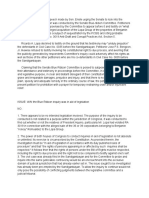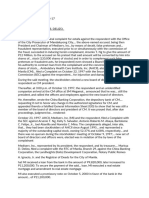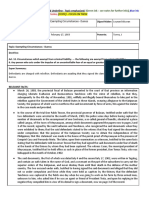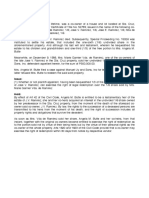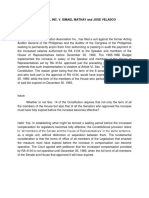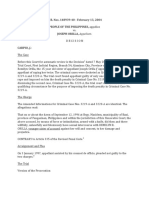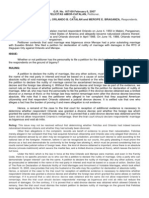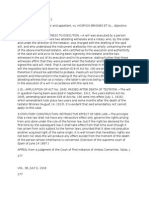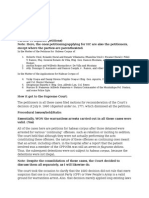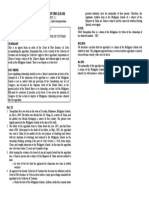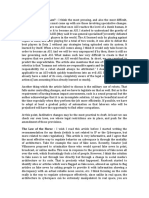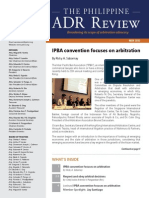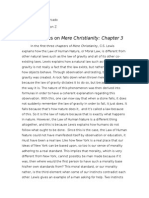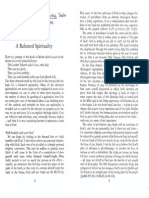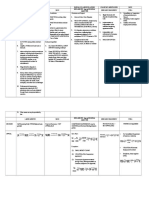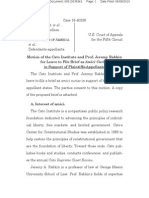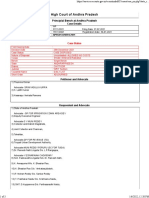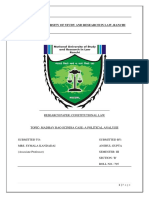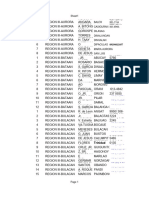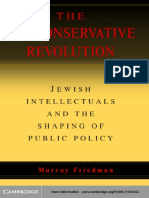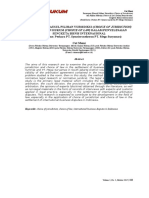Tolentino v. COMELEC
Tolentino v. COMELEC
Uploaded by
Anton MercadoCopyright:
Available Formats
Tolentino v. COMELEC
Tolentino v. COMELEC
Uploaded by
Anton MercadoOriginal Description:
Copyright
Available Formats
Share this document
Did you find this document useful?
Is this content inappropriate?
Copyright:
Available Formats
Tolentino v. COMELEC
Tolentino v. COMELEC
Uploaded by
Anton MercadoCopyright:
Available Formats
TOLENTINO v COMELEC (1971)
FACTS:
The Constitutional Convention of 1971
approved Organic Resolution No. 1 which
amended the age qualification for the exercise
of suffrage from 21 to 18.
President Diosdado Macapagal then sent a
letter to COMELEC calling upon the
commission to help the Convention implement
the said resolution.
On 20 September 1971, COMELEC then
"RESOLVED to inform the Constitutional
Convention that it will hold the plebiscite on
condition that:
a) The Constitutional Convention will
undertake the printing of separate
official ballots, election returns and tally
sheets for the use of said plebiscite at
its expense;
b) The Constitutional Convention will adopt
its own security measures for the
printing and shipment of said ballots and
election forms; and
c) Said official ballots and election forms
will be delivered to the Commission in
time so that they could be distributed at
the same time that the Commission will
distribute its official and sample ballots
to be used in the elections on November
8, 1971.
To implement the Resolution, the President
issued an order forming an Ad Hoc Committee.
Implementing guidelines were issued and
approved by the President who then
transmitted the same to COMELEC. On 7
October 1971, The Convention approved a
resolution calling for a recess of the
Convention from 1 November 1971 to 9
November 1971 to permit the delegates to
campaign for the ratification of Organic
Resolution No. 1. On 12 October 1971, the
Convention passed Resolution No. 24
confirming the authority of the President of the
Constitution to implement Organic Resolution
No. 1, including the creation of the Ad Hoc
Committee ratifying all acts performed in
connection with said implementation.
The scheduled advance plebiscite concerns
only the amendments included in Organic
Resolution No. 1 and this was even before the
rest of the draft of the Constitution had been
approved.
ISSUE:
WON there is any limitation or condition in
Section 1 of Article XV of the Constitution
which is violated by the act of the Convention
of calling for a plebiscite on the sole
amendment contained in Organic Resolution
No. 1?
HELD/RATIO:
Yes, it violates the condition and limitation that
al the amendments to be proposed by the
same Convention must be submitted to the
people in a single election or plebiscite.
Section 1, Article XV definitely provides that
such amendments shall be valid as part of this
Constitution when approved by a majority of
the votes at an election at which the
amendments are submitted to the people for
their ratification --- this provision unequivocally
says an election which means only one.
The Court has no desire at all to hamper and
hamstring the noble work of the Constitutional
Convention . We are not denying any right of
the people to vote on the proposed
amendment; We are only holding that under
Section 1, Article XV of the Constitution, the
same should be submitted to them not
separately from but together with all the
other amendments to be proposed by this
present Convention.
In order that a plebiscite for the ratification of
an amendment to the Constitution may be
validly held, it must provide the voter not only
sufficient time but ample basis for an intelligent
appraisal of the nature of the amendment per
se as well as its relation to the other parts of
the Constitution with which it has to form a
harmonious whole.
MR for TOLENTINO v COMELEC
Reconsideration of the decision is sought on
the following grounds:
(1) That inasmuch as Congress, acting as
a constituent assembly, can submit to
a plebiscite, whether, singly or together,
the constitutional amendments it may
propose, the Convention being at par
with such constituent assembly
= Although Congress as the legislature
is a continuing body, factually and in
contemplation of law, it is not so
whenever it sits in its capacity as a
constituent assembly. In the latter
instance, its juridical existence as such
is coextensive only with the legal
duration of the joint session assembled
to perform any particular work of
proposing
amendments
to
the
Constitution. In the juridical sense, each
such joint session is a constitutional
convention in itself, distinct and
separate from the others of similar
nature, and may be distinguished from
the convention per se.
Consequently, while Congress may
easily reconvene as another constituent
body after it has finally adjourned as
such, from the very nature of its
existence, a new call for election of
delegates who would compose a new
Constitutional Convention would be
needed.
(2) That the phrase at an election in
Section 1 of Article XV of the
Constitution does not necessarily mean
only one plebiscite but may be
construed as signifying several
plebiscites,
because
there
is
jurisprudence holding that a word in
singular in a statute or constitution may
be understood in the plural;
= We went further and construed
assailed provision, by going behind
actual words and ascertaining
purpose and intent of the framers of
Constitution.
the
the
the
the
Nothing in the Decision denies the
possibility that the phrase an election
may comprehend more than one
plebiscite; what the Court held in effect
with the spirit of the provisions, is that
which proscribes piece-meal submission
before the whole draft of the new
Constitution or all the amendment to be
proposed have been finally approved by
that body, considering that before that
there could be no safe frame of
reference
for
intelligent
voting,
especially because the particular
amendment proposed is subject to
many undefined reservations which it is
in the power of the Convention to
approve at any time before or after the
ratification of their final handiwork.
(3) That the question of whether or not the
Convention
should
submit
the
amendments it may propose in a single
plebiscite or otherwise is a matter that
goes into the wisdom of the action of
the Convention rather than to its
authority or power, hence outside the
pale of judicial review.
= the movants have confused wisdom
of the questioned action taken by the
Convention with the wisdom of the
provisions of Section 1 of Article XV of
the Constitution which is applicable
thereto. What We discussed in Our
decision is not whether or not the
Convention acted wisely; We simply
held that for the reasons given in the
decision, We see wisdom in the
construction
that
piece-meal
submission, before all the proposed
Constitutional amendments as a whole
have been approved, is not allowed by
the Constitution.
(4) And that, in relation to the point in the
decision to the effect that the proposed
amendment in question regarding the
reduction of the voting age in the
Philippines has no frame of reference
because the proposed amendment is a
simple fixing of the minimum voting age
from 21 to 18, and it is difficult to
conceive of any possible future
amendments where (sic) this fixed
voting age could be out of tune and
hard to imagine how this amendment
on this minimum voting age could
conceivably be better understood if
presented together with the various
substantial
and
fundamental
amendments in the whole draft when
concluded,
= The right to vote is not as simple as it
might appear to be when considered in
relation to the form of government, the
fundamental
principles
and
the
educational policies, inter alia, that the
other amendments to the Constitution
may adopt and pursue.
In the way that the proposal is worded,
read together with the reservations
tacked to it by the Convention thru
Section 3 of the questioned resolution, it
is too much of a speculation to assume
what exactly the amendment would
really amount to in the end.
BAYAN v ZAMORA (2000)
FACTS:
The United States panel met with the
Philippine panel to discussed, among others,
the possible elements of the Visiting Forces
Agreement (VFA). This resulted to a series of
conferences
and
negotiations
which
culminated on January 12 and 13, 1998.
Thereafter, President Fidel Ramos approved
the VFA, which was respectively signed by
Foreign Affairs Secretary Siazon and United
States Ambassador Thomas Hubbard.
On 5 October 1998 Pres. Estrada through Sec.
of Foreign Affairs ratified the VFA. Senate
approved it by 2/3 votes on 27 May 1989. On 1
June 1999, the VFA officially entered into
force. On the whole, the VFA is an agreement
which defines the treatment of United States
troops and personnel visiting the Philippines. It
provides for the guidelines to govern such
visits of military personnel, and further defines
the rights of the United States and the
Philippine government in the matter of criminal
jurisdiction, movement of vessel and aircraft,
importation and exportation of equipment,
materials and supplies.
Petitioners: Section 25, Article XVIII is
applicable considering that the VFA has for its
subject the presence of foreign military troops
in the Philippines.
Respondents: Section 21, Article VII should
apply inasmuch as the VFA is not a basing
arrangement but an agreement which involves
merely the temporary visits of United States
personnel engaged in joint military exercises.
ISSUE:
1. Is the VFA governed by the provision of
Section 21, Article VII or of Section 25,
Article XVII of the Constitution?
- Section 25, Article XVIII, which
specifically deals with treaties
involving foreign military bases,
troops, or facilities, should apply in
the instant case.
- To a certain extent and in a limited
sense, however, the provisions of
section 21, Article VII will find
applicability with regard to the issue
and for the sole purpose of
determining the number of votes
required to obtain the valid
concurrence of the Senate, as will be
further discussed hereunder.
2. WON the requirements of Section 25
were complied with when the Senate
gave its concurrence to the VFA
Section
foreign
facilities
following
viz:
25, Article XVIII disallows
military bases, troops, or
in the country, unless the
conditions are sufficiently met,
it must be under a treaty;
A treaty, as defined by the
Vienna Convention on the
Law of Treaties, is an
international
instrument
concluded between States in
written form and governed by
international law, whether
embodied
in
a
single
instrument or in two or more
related
instruments,
and
whatever
its
particular
designation.
the treaty must be duly concurred
in by the Senate and, when so
required by congress, ratified by a
majority of the votes cast by the
people in a national referendum;
Section 25, Article XVIII must
be related and viewed in light
of
the
clear
mandate
embodied in Section 21,
Article VII, which in more
specific terms, requires that
the concurrence of a treaty, or
international agreement, be
made by a two -thirds vote of
all the members of the
Senate.
recognized as a treaty by the other
contracting state.
the phrase recognized as a
treaty means that the other
contracting party accepts or
acknowledges the agreement
as a treaty
The records reveal that the
United States Government,
through Ambassador Thomas
C. Hubbard, has stated that
the United States government
has fully committed to living
up to the terms of the VFA
With the ratification of the
VFA, which is equivalent to
final acceptance, and with the
exchange of notes between
the Philippines and the United
States of America, it now
becomes
obligatory
and
incumbent on our part, under
the principles of international
law, to be bound by the terms
of the agreement.
You might also like
- 129 SCRA 174 Pesigan Vs AngelesDocument4 pages129 SCRA 174 Pesigan Vs AngelesFran SuarezNo ratings yet
- Committee of 300 The Conspirator's Hierarchy by John Coleman - SUMMARYDocument19 pagesCommittee of 300 The Conspirator's Hierarchy by John Coleman - SUMMARYKeith Knight100% (6)
- Andrew Jackson Hero or VillainDocument11 pagesAndrew Jackson Hero or Villainapi-437015339No ratings yet
- Tolentino Vs Commission On Elections Case DigestDocument3 pagesTolentino Vs Commission On Elections Case DigestDaf MarianoNo ratings yet
- Tolentino Vs COMELEC DDocument1 pageTolentino Vs COMELEC DSyd Geemson ParrenasNo ratings yet
- Bengzon V Senate Blue Ribbon DigestDocument2 pagesBengzon V Senate Blue Ribbon DigestAli BastiNo ratings yet
- Arnault Vs BalagtasDocument3 pagesArnault Vs BalagtasRoberts SamNo ratings yet
- Digested Case of Atizado V People of The Philippines.Document2 pagesDigested Case of Atizado V People of The Philippines.Shyly Cubalan-BalbinNo ratings yet
- People Vs DelizoDocument3 pagesPeople Vs DelizomelvinNo ratings yet
- Macariola vs. Asuncion (Case Digest)Document2 pagesMacariola vs. Asuncion (Case Digest)JamMenesesNo ratings yet
- Atizado Vs PeopleDocument9 pagesAtizado Vs PeopleGee AnneNo ratings yet
- PFR Case Digest.Document11 pagesPFR Case Digest.Airelle AvilaNo ratings yet
- Facts:: 21. Tecson V Comelec Ronald Alland Kelly Poe (Consolidated)Document3 pagesFacts:: 21. Tecson V Comelec Ronald Alland Kelly Poe (Consolidated)Emma Ruby AguilarNo ratings yet
- G.R. No. 100776, October 28, 1993 Chief Justice NarvasaDocument1 pageG.R. No. 100776, October 28, 1993 Chief Justice NarvasaRoyce HernandezNo ratings yet
- Laurel Vs GarciaDocument5 pagesLaurel Vs GarciaDolores PulisNo ratings yet
- Veterans Federation of The PH v. ReyesDocument2 pagesVeterans Federation of The PH v. Reyesviva_33No ratings yet
- In Re ShoopDocument31 pagesIn Re ShoopNenita Wella Jose AguilarNo ratings yet
- US Vs Exaltacion BBBBBBDocument2 pagesUS Vs Exaltacion BBBBBBMonikka0% (1)
- Hernandez Vs SantosDocument2 pagesHernandez Vs SantosAllen SoNo ratings yet
- ALCORAN - US v. ExaltacionDocument3 pagesALCORAN - US v. ExaltacionLeynard AlcoranNo ratings yet
- G.R. No. 448 U.S. vs. Sweet, 1 Phil. 18Document2 pagesG.R. No. 448 U.S. vs. Sweet, 1 Phil. 18Shereen AlobinayNo ratings yet
- People Vs LimDocument1 pagePeople Vs LimAdriann Juanir CastañedaNo ratings yet
- Butte V Manuel Uy & SonsDocument1 pageButte V Manuel Uy & SonsaraNo ratings yet
- Bayan vs. Executive SecretaryDocument49 pagesBayan vs. Executive SecretaryJerry SerapionNo ratings yet
- Centeno v. Villalon Pornillos, GR No. 113092, September 1, 1994Document2 pagesCenteno v. Villalon Pornillos, GR No. 113092, September 1, 1994Judy Anne RamirezNo ratings yet
- Ligot Vs MathayDocument1 pageLigot Vs MathayVanessa Evans CruzNo ratings yet
- Mitra Vs ComelecDocument12 pagesMitra Vs ComelecjazrethNo ratings yet
- Pil - CD1Document34 pagesPil - CD1Reyshanne MarquezNo ratings yet
- The Plight of ABS CBN by Justice Noel Gimenez Tijam Ret.Document26 pagesThe Plight of ABS CBN by Justice Noel Gimenez Tijam Ret.Rhege AlvarezNo ratings yet
- In Re Benjamin DacanayDocument4 pagesIn Re Benjamin Dacanayjeesup9No ratings yet
- G.R. No. 190749 - Zafra Vs PeopleDocument7 pagesG.R. No. 190749 - Zafra Vs PeopleMarkNo ratings yet
- de Venecia vs. SandiganbayanDocument2 pagesde Venecia vs. SandiganbayanGelay PererasNo ratings yet
- G.R. No. L-14628 Hermosisima Vs CADocument4 pagesG.R. No. L-14628 Hermosisima Vs CAFe GregorioNo ratings yet
- Integrated Bar of The Philippines v. Hon. Ronaldo B. ZamoraDocument16 pagesIntegrated Bar of The Philippines v. Hon. Ronaldo B. ZamorabearzhugNo ratings yet
- Constitutional Law 1 - Prof. Alberto Muyot CASE DIGEST For F2021Document2 pagesConstitutional Law 1 - Prof. Alberto Muyot CASE DIGEST For F2021alfredNo ratings yet
- Philconsa v. Mathay DigestDocument1 pagePhilconsa v. Mathay DigestNoreen NombsNo ratings yet
- People vs. OrillaDocument19 pagesPeople vs. Orillacmge_2005No ratings yet
- Facts:: Mo Ya Lim Yao vs. Commissioner of Immigration GR L-21289, 4 October 1971Document2 pagesFacts:: Mo Ya Lim Yao vs. Commissioner of Immigration GR L-21289, 4 October 1971angelyn susonNo ratings yet
- Eugenio v. VelezDocument2 pagesEugenio v. VelezDerick TorresNo ratings yet
- Stat ConDocument2 pagesStat ConRodolfo Dagooc Jr.No ratings yet
- People of The Philippines V OrillaDocument1 pagePeople of The Philippines V OrillaSophia GibaNo ratings yet
- #7 Llorente V CADocument1 page#7 Llorente V CAVicente Del Castillo IVNo ratings yet
- Those Whose Fathers Are Citizens of The PhilippinesDocument20 pagesThose Whose Fathers Are Citizens of The PhilippinesRA BautistaNo ratings yet
- The United States Vs Juan PonsDocument3 pagesThe United States Vs Juan PonsMczoC.MczoNo ratings yet
- Catalan v. CADocument1 pageCatalan v. CAInes Hamoy JunioNo ratings yet
- Gonzales vs. COMELEC - DigestDocument2 pagesGonzales vs. COMELEC - DigestStruggler 369No ratings yet
- 2 Characteristics and Basic PrinciplesDocument33 pages2 Characteristics and Basic PrinciplesMichael A. BerturanNo ratings yet
- Case Digest For Constitutional LawDocument107 pagesCase Digest For Constitutional Lawcarl fuerzasNo ratings yet
- Prospective and Retroactive Effect of Laws Bernabe vs. Alejo G.R. No. 140500 January 21, 2002 FactsDocument1 pageProspective and Retroactive Effect of Laws Bernabe vs. Alejo G.R. No. 140500 January 21, 2002 FactsJhenjhen GandaNo ratings yet
- Case 119 Almario Vs Executive SecretaryDocument3 pagesCase 119 Almario Vs Executive Secretaryangelo doceoNo ratings yet
- Persons DigestDocument20 pagesPersons DigestAJ RamirezNo ratings yet
- Joselito Peralta Y Zareno, Petitioner, vs. People of The Philippines, Respondent. DecisionDocument5 pagesJoselito Peralta Y Zareno, Petitioner, vs. People of The Philippines, Respondent. DecisionGinn UndarNo ratings yet
- People v. Jacinto, G.R. No. 182239, 16 March 2011Document2 pagesPeople v. Jacinto, G.R. No. 182239, 16 March 2011Nico IanNo ratings yet
- Salenilla V ComelecDocument2 pagesSalenilla V ComelecJohnson YaplinNo ratings yet
- Cardenas Vs Cardenas RinenDocument4 pagesCardenas Vs Cardenas RinenNicole PTNo ratings yet
- Borromeo-Herrera Vs BoromeoDocument2 pagesBorromeo-Herrera Vs BoromeoKeanu RibsNo ratings yet
- Bona vs. Briones., 38 Phil. 276, July 06, 1918Document7 pagesBona vs. Briones., 38 Phil. 276, July 06, 1918KPP100% (1)
- Umil V Ramos (1991)Document6 pagesUmil V Ramos (1991)Gabe RuaroNo ratings yet
- 345 Amante Roa V Insular Collector of CustomsDocument1 page345 Amante Roa V Insular Collector of CustomsCarissa CruzNo ratings yet
- Consti 2 Cases Jan 26, '18Document7 pagesConsti 2 Cases Jan 26, '18Rafael AdanNo ratings yet
- Respondents, Raul S. Manglapus, Jesus G. Barrera, Pablo S. Trillana Iii, Victor de LaDocument2 pagesRespondents, Raul S. Manglapus, Jesus G. Barrera, Pablo S. Trillana Iii, Victor de Lacarmzy_ela24No ratings yet
- Tolentino Vs ComelecDocument3 pagesTolentino Vs ComelecChammyNo ratings yet
- Legality of Checkpoints in PHDocument2 pagesLegality of Checkpoints in PHAnton MercadoNo ratings yet
- Application Information CSD-ODI FORM 1 (Revised 2019)Document1 pageApplication Information CSD-ODI FORM 1 (Revised 2019)Anton Mercado100% (1)
- Digests 3Document17 pagesDigests 3Anton MercadoNo ratings yet
- Art. 428 Civil Code Paras, 2016 Page 89Document1 pageArt. 428 Civil Code Paras, 2016 Page 89Anton MercadoNo ratings yet
- Do We Need Robot LawDocument2 pagesDo We Need Robot LawAnton MercadoNo ratings yet
- Dept Order No - 147-15Document1 pageDept Order No - 147-15Anton Mercado100% (1)
- Lazarte SUPREME COURT CASEDocument14 pagesLazarte SUPREME COURT CASEAnton MercadoNo ratings yet
- Loving V VirginiaDocument10 pagesLoving V VirginiaAnton MercadoNo ratings yet
- RR 20-2002Document1 pageRR 20-2002Anton MercadoNo ratings yet
- Origs 3Document135 pagesOrigs 3Anton MercadoNo ratings yet
- The Six Thinking Hats Exercise GuideDocument1 pageThe Six Thinking Hats Exercise GuideAnton MercadoNo ratings yet
- The Philippine Alternative Dispute Resolution ReviewDocument4 pagesThe Philippine Alternative Dispute Resolution ReviewAnton MercadoNo ratings yet
- Is Morality A Relative Term? or Is There A Standard To Morality?Document3 pagesIs Morality A Relative Term? or Is There A Standard To Morality?Anton MercadoNo ratings yet
- Rules 6 & 7 Rules For Civil ProcedureDocument6 pagesRules 6 & 7 Rules For Civil ProcedureAnton MercadoNo ratings yet
- History 166 Midterm ReviewerDocument34 pagesHistory 166 Midterm ReviewerAnton Mercado100% (1)
- A Balanced Spirituality by Donal DorrDocument6 pagesA Balanced Spirituality by Donal DorrAnton Mercado100% (1)
- Labor JurisdictionDocument2 pagesLabor JurisdictionAnton MercadoNo ratings yet
- Connecting The Dots: Facebook Use and Studying CorrelatedDocument4 pagesConnecting The Dots: Facebook Use and Studying CorrelatedAnton MercadoNo ratings yet
- IRR of Kasambahay LawDocument19 pagesIRR of Kasambahay LawAnton MercadoNo ratings yet
- Rules 6 & 7 Rules For Civil ProcedureDocument6 pagesRules 6 & 7 Rules For Civil ProcedureAnton MercadoNo ratings yet
- House Bill 5417Document12 pagesHouse Bill 5417Anton MercadoNo ratings yet
- Cato Institute Amicus Brief - Texas v. United StatesDocument45 pagesCato Institute Amicus Brief - Texas v. United StatesjoshblackmanNo ratings yet
- Republic v. TeamDocument2 pagesRepublic v. TeamannedefrancoNo ratings yet
- Rahul A. Sirohi - From Developmentalism To Neoliberalism - A Comparative Analysis of Brazil and India (2019, Palgrave Macmillan)Document242 pagesRahul A. Sirohi - From Developmentalism To Neoliberalism - A Comparative Analysis of Brazil and India (2019, Palgrave Macmillan)Nelson AlvarezNo ratings yet
- Newspaper Rules DiscussionDocument2 pagesNewspaper Rules Discussionzulfaapylman350No ratings yet
- 1 - People v. CaoileDocument2 pages1 - People v. CaoiledNo ratings yet
- Sialkot Punjab Intra-Party Elections (Contested Results)Document11 pagesSialkot Punjab Intra-Party Elections (Contested Results)PTI OfficialNo ratings yet
- Case Status: High Court of Andhra Pradesh WP 15511/2021Document3 pagesCase Status: High Court of Andhra Pradesh WP 15511/2021PGurusNo ratings yet
- John Kerry Debriefing of Drug Traffficker George Morales About His Ties To CIA and ContrasDocument10 pagesJohn Kerry Debriefing of Drug Traffficker George Morales About His Ties To CIA and ContrasChad B HarperNo ratings yet
- Gaudencio Rayo Vs Cfi BulacanDocument2 pagesGaudencio Rayo Vs Cfi BulacanAngela Marie AlmalbisNo ratings yet
- Captains of The Civil War A Chronicle of The Blue and The Gray by Wood, William (William Charles Henry), 1864-1947Document152 pagesCaptains of The Civil War A Chronicle of The Blue and The Gray by Wood, William (William Charles Henry), 1864-1947Gutenberg.orgNo ratings yet
- UntitledDocument77 pagesUntitledapi-163513145No ratings yet
- NSTP Civic Welfare Training Service 1Document229 pagesNSTP Civic Welfare Training Service 1Aj SarmientoNo ratings yet
- Guidance On The Use of Progressive Discipline and Tables of PenaltiesDocument7 pagesGuidance On The Use of Progressive Discipline and Tables of PenaltiesFedSmith Inc.No ratings yet
- Research Paper Consti PDFDocument10 pagesResearch Paper Consti PDFParul GuptaNo ratings yet
- Elections and Voting British English TeacherDocument4 pagesElections and Voting British English TeacherAnna MushenkoNo ratings yet
- Mayor Reg 3Document12 pagesMayor Reg 3Cess SexyNo ratings yet
- Tory Councillor DossierDocument48 pagesTory Councillor DossierMatesJacob100% (2)
- Women in Peace and Transition Processes: Somalia (2000)Document12 pagesWomen in Peace and Transition Processes: Somalia (2000)kermitNo ratings yet
- The Neoconservative Revolution Jewish Intellectuals and The Shaping of Public Policy Murray FriedmanDocument311 pagesThe Neoconservative Revolution Jewish Intellectuals and The Shaping of Public Policy Murray Friedmansavic11100% (1)
- Casco Phil Chemical V GimenezDocument2 pagesCasco Phil Chemical V GimenezDominique VasalloNo ratings yet
- Constitution of India Professional Ethics Jan 2014 PDFDocument4 pagesConstitution of India Professional Ethics Jan 2014 PDFj.p.reninNo ratings yet
- Rise of Fascism and NazismDocument12 pagesRise of Fascism and NazismMatías Rodríguez .-.No ratings yet
- Chapter 7 Sa LeaDocument21 pagesChapter 7 Sa LeacastromayorianleirNo ratings yet
- FY 2021 American Rescue Plan Act (H8F) : Funding For Health CentersDocument18 pagesFY 2021 American Rescue Plan Act (H8F) : Funding For Health CentersManikanta Sai KumarNo ratings yet
- 420 SCRA 438 Tolentino v. ComelecDocument16 pages420 SCRA 438 Tolentino v. ComelecPeter Paul RecaboNo ratings yet
- Zeri I Camerise 10Document24 pagesZeri I Camerise 10Zeri i CameriseNo ratings yet
- 1069 2384 1 PBDocument46 pages1069 2384 1 PBQonita AlisyaNo ratings yet
- Certificate of Candidacy SSGDocument2 pagesCertificate of Candidacy SSGRegie MadayagNo ratings yet





